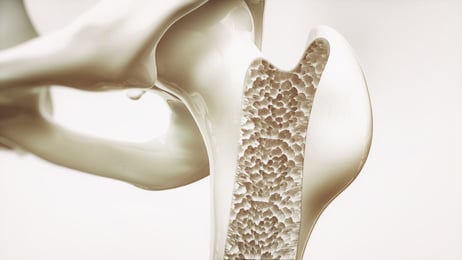The title of today’s post refers to the problematic issue, that is, supplementation of vitamin D. I have been thinking how to touch upon this subject for a while and I think I will just present you with data and guidelines that I was able to find in medical literature.


The most important role of vitamin D in a human body is its participation in bone mineralisation. It also regulates absorption of calcium and phosphates from the intestine. Vitamin D insufficiency stimulates the body to produce parathormone (PTH), resulting in release of calcium from bones to the blood and, in consequence, leading to rickets or osteomalacia.
What is the difference between these two diseases? The age criterion. Rickets is a children’s disease that appears during be period of bone growth. Meanwhile, osteomalacia is a disease of bones that are no longer growing. The issue of rickets and its diagnosis is a big enough topic for a separate post. Today I would like to focus, though, mainly on vitamin D
In the table below I provided the recommendations regarding vitamin D supplementation based on two articles: Practical guidelines for the supplementation of vitamin D and the treatment of deficits in Central Europe – recommended vitamin D intakes in the general population and groups at risk of vitamin D deficiency (Endokrynologia Polska; 2013; 64) and Global consensus recommendations on prevention and management of nutritional rickets (Journal of Clinical Endocrinology and Metabolism; 2016; 101).
Supplementation of vitamin D in the population (IU / 24h)
| Practical guidelines for supplementation of vitamin D |
Global consensus recommendations |
||
|---|---|---|---|
|
0 – 6 m. |
400 IU/24h |
||
|
6 – 12 m. |
400 – 600 IU/24h | < 12 m. | 400 IU/24h |
|
12 – 18 y. |
600 – 1000 IU/24h | > 12 m. | 600 IU/24h |
|
> 18 y. |
800 – 2000 IU/24h | Adults | 600 IU/24h |
|
Pregnancy and lactation |
1500 – 2000 IU/24h |
Pregnancy and lactation |
600 IU/24h |
In Poland, on the packaging of supplements you can encounter the dosage of vitamin D stated in “j.m.”, which is exactly the same thing as “IU”. The recommendations I mentioned apply first and foremost to prevention of rickets and osteomalacia. In adults they should be applied depending on the concentration of 25 (OH)D in the body. In children younger than 12 months old, preventive supplementation is recommended, irrespective of the level of 25 (OH)D, from September to May. A paediatrician decides whether preventive supplementation with vit. D is required in older children. The table below shows what levels are considered insufficient and require supplementation:
|
Practical guidelines
|
Global consensus recommendations
|
|
|---|---|---|
|
Deficit |
0 – 50 nmol/l (0-20ng/ml) |
< 30 nmol/l (12ng/ml) |
|
Suboptimal concentration |
> 50 – 75 nmol/l (>20-30ng/ml) |
30 – 50 nmol/l (12-20ng/ml) |
|
Optimal concentration |
> 75 – 125 nmol/l (>30-50ng/ml) |
> 50 nmol/l (>20ng/ml) |
|
Toxic concentration |
> 250 nmol/l (>100ng/ml) |
> 250 nmol/l (>100ng/ml) |
I was also wondering whether I should start giving my child vitamin D and, if so, in what form. Up to the 12th month of child’s life it is worth using a ready-made supplement with the required dose of 400 IU from September to May. Later on, I was giving my daughter the train oil, containing not only vitamin D but also DHA acids.
The principles of vitamin D supplementation I mentioned are aimed at preventing rickets and osteomalacia. Recently, we have experienced a wave of reports regarding the impact of vitamin D also on other systems of our body.
Scientists have demonstrated a relationship between low level of vitamin D in blood and diseases such as: colorectal cancer, mammary cancer, breast cancer, prostate cancer, multiple sclerosis, diabetes, asthma, inflammatory bowel disease, heart diseases, depression.
Quite scary, isn’t it? There is only one “but” that came to my mind after reading the article of Piotr Dziechciarz, M.D., Ph.D. (a paediatrician from the Paediatry Department of the Medical University of Warsaw). The fact that low levels of vitamin D were found in the blood of people suffering from the above mentioned diseases does not have to mean that supplementing vitamin D is going to help us prevent them.

In general, vitamin D is synthesised in skin thanks to UV radiation. To be more precise, it is the UVB radiation to causes production of vitamin D3 in the epidermis. And now… let us go further – a high level of vitamin D in blood may be related to staying outdoors often and engaging in physical activity. People who are ill often lead more of a stay-at-home lifestyle so it is easy to explain why their blood levels of vitamin D are lower. Physical activity is one of the methods of preventing heart diseases and cancer so it basically goes together with higher levels of vitamin D in the blood of people who run or ride a bicycle regularly. This proves that demonstrating only the relationship between a disease and low levels of vitamin D in blood is nothing more than a starting point for further research.

In 2014 there was published an overview of meta-analyses of observation studies and studies involving randomisation regarding the relationship between vitamin D and its impact on systems of our body other than the skeletal system. These studies were carried out by Cochrane Collaboration. Here are the conclusions:
- no study confirmed the relationship between vitamin D supplementation and prevention of cancer. In two papers it was demonstrated that such supplementation may decrease the risk of death related to a cancer, but the detailed analysis showed that this result may result from random error;
- no study confirmed the relationship between vitamin D supplementation and the risk of death due to heart disease;
- the impact of vitamin D supplementation in children on the frequency of respiratory tract infections was not demonstrated;
- there was demonstrated a beneficial impact of supplementation on minimising the frequency of respiratory tract infections in children suffering from asthma;
- there was demonstrated the impact of vitamin D supplementation on the risk of preterm birth and low infant birth weight (supplementing vitamin D minimises that risk);
- there was not demonstrated the impact of vitamin D on body mass (supplementing it has no impact on lowering the BMI).
Obviously, the studies on vitamin D supplementation and its relationship with various diseases continue to be carried out. Perhaps later on there will appear other revolutionary data on that subject.
To conclude, I would like to quote Piotr Dziechciarz, M.D., Ph.D., who I already mentioned before:
The market of vitamin D products is one of the most dynamically developing dietary supplement markets in Poland. The value of vitamin D supplements sold during the period from January 2015 to February 2016 amounts to about 125 million Polish zlotys. In comparison to the previous year, it increased by almost 100% and in comparison to 2012 by almost 600%.
Phew… This is it. We have made it through this. So, I am going to leave you, Ladies and Gentlemen, so that you can reflect on it while I do some cycling.














